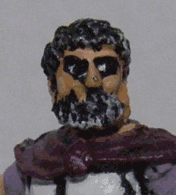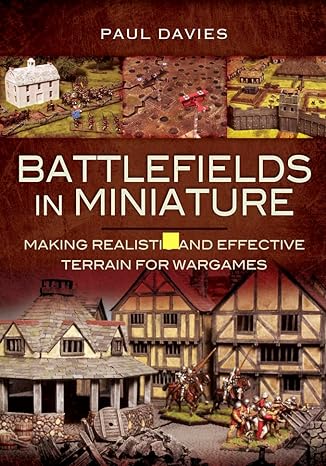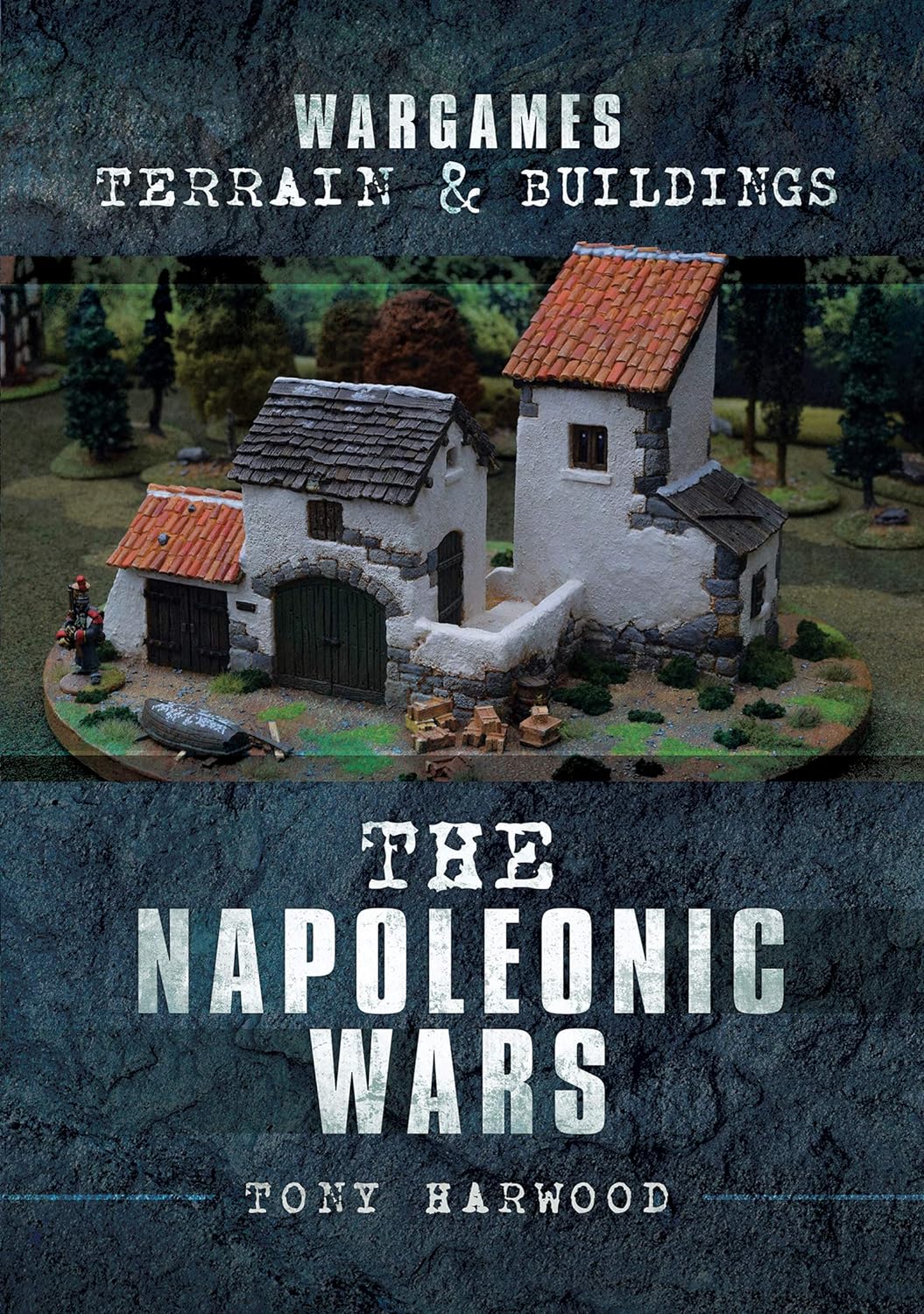Field of Glory Wargaming at Roll Call 2008 - Game 3
After a great Hungarian/Bulgarian curry on Saturday night, Sunday saw us scraping show off the car in order to head back to Reading for another bout of dice rolling amusement.
This time I was facing what should surely be another "proper" balanced army - Bosporans.
You can see the list and find out all about the Bosporans here
Pictures of Bosporan Troops from my Ancients Photo Directory
 |
 |
The terrain had fallen mostly on one flank, creating an obvious channel down which the Bosporan cavalry would hopefully charge to their doom against my legions, as my Dacians swung round remorselessly onto their flanks after dominating the rough terrain. The Bosporans also had a raft of totally rubbish light infantry, so maybe my "outmatch them" tactic could work to my advantage there as well?
Deployment seemed to go to plan, with only the surprise arrival of lots of Roman allied legions (in 4's), as well as some "almost-a-legionary" Bosporan city militia to catch me out.

The Dacians - and the massed high quality Roman light foot - sensed an opportunity and raced forward as the Bosporan city militia deployed at the far edge of the ploughed field, ready to defend their strangely familiar city in the far distance.

The Legions had an uninterrupted view across the open field and advanced boldly to try and force the Bosporans into committing their cavalry to the frontal combat.
Things also looked good on the left - in theory. The average Roman skirmishers were outnumbered, but the Bosporans were poor so surely they could not stand up against sustained shooting? Well, in fact they could - the Bosporans, taking advantage of the cover provided by a hedged field struck first, disrupting the velites and de-toothing the attack of the Roman light troops.
On the far edge a Bosporan general was adding his encouragement to a unit of 4 Bosporan super-duper LH with Bw and Sw - even as my Numidians moved up, the Bosporans smiled sneakily as they had already heard from the first game report that they were actually better in combat than the Numidians
The Romans continued to put the squeeze on the Bosporans - even allowing the Roman cavalry to help gang up on the Bosporan light horse wing relatively unimpeded? How would the Bosporans react?
They reacted by detaching a unit of lancers to ignore the slow moving legions and threaten the Roman cavalry! With rough terrain under their hooves, the Roman cavalry did have an option to try and neutralize the lance advantage of the Bosporans - if they could work out how to use it!
But, cleverly, in that way only drilled troops can manage, the Romans moved out of range of an immediate flank charge by contracting into the rough ground! But time was short, the lancers would not wait forever, and the Roman needed to force the pace against the slightly weaker Bosporan cavalry force facing them
The Dacians were now getting itchy for the protecting Roman light foot to do their work - but even being better quality, and with rear support as well the Romans were losing the shooting battle against equal numbers of poor troops. At least the Numidians were holding their own in combat against the Bosporan light horse, and the Roman bowmen waded in to help make sure of a place where I had a small advantage developing.
With one cavalry unit drawn out of the main line, the Romans had an opportunity to defeat the Bosporans piecemeal. The Legionary line moved up to tempt a lone Bosporan unit into a dangerous charge - and they duly obliged, hitting both 8-strong Legionary blocks totally unsupported. Evens at impact, but then the boys in Red would outnumber the Bosporans 2:1 in dice in an evens melee. 8 dice must surely mean a dead horseman and a disrupted Bosporan unit?
Well, actually not, as the Bosporans rallied back without suffering any ill effects from their ridiculously optimistic attack.
Meanwhile, with the other Bosporan lancer unit now threatening the Roman cavalry's flank, the Numidians had attempted to leverage their advantage at impact and initiated a combat of LH vs LH. Of course, this fairly even combat resulted in an almost instant victory for the Bosporans against the Roman light horse bowmen whilst the brave, theoretically fantastic Numidians struggled to do much more than slip down the cohesion level faster than their opponents.
The Dacians lost patience with their velites, who were stubbornly refusing to rally from disrupted, and charged to clear the enemy skirmishers out of the way.
But by now the Bosporans had managed to move up their own legions, and launched another co-ordinated attack on the Roman Legions combining mounted and foot charges. Everyone was at evens across the line, but the Real Romans ignored the odds and decided this was their time to lose bases and to start to drop cohesion against their enemies.
And dropping cohesion is only a one way process, as the legion collapsed in very short order. At least the proper Romans had only thrown away one unit in losing to two Bosporan ones.....
Back on my right and the Roman cavalry were engaged in a desperate battle against the lance-less Bosporans. The Romans struck the first blow, disrupting the Bosporans however as the Numidians had by now also evaporated, Bosporan light horse were now free to charge their rear. Even fighting the light horse off to disrupted, things looked bleak for the Roman cavalry. It was time for a Dacian Charge to rescue the day!
Realising they could get in a charge against the City Militia and stay in the rough terrain, the General-led Dacians charged home hoping their greater unit size and as-good at impact quality would help them win by attrition against the small Militia units.
But small units one one side were counteracted by small numbers on the dice on the Dacian side, as a surprise 2-0 first-round combat loss was followed by a triple-1 on death and cohesion tests, sending the Dacian vanguard crashing to an instant fragmented status at first contact!!
Pants!!
In the middle things were also going from bad to worse. Despite fighting only one 4-strong unit of cavalry at evens, the other 8-strong legion swiftly crumbled to defeat and rout, losing bases in the process.
The only part of the line that was doing OK was the 6-strong average quality legion, without the benefit of a general to help them either. Fighting off 8 Superior legions with better sword skills, they were trading disruption markers and casualties, and held up the Romans long enough for the Ligurians to charge in from the flank, to deliver a stunning blow .....the Romans were now fragmented!
oh, no, wait, the Ligurians lost the combat. And so did the Average legion. One hit out of 8 dice from the Real Romans, 5 hits out of 5 from Allied Romans.
With that the average Romans also broke, and the game was lost
Post Match Summary
For a time this game seemed to be going well. Good matchups - in theory. The Bosporans committed their cavalry in piecemeal fashion, even the cavalry battle on the right was not too bad.
But once it got to combat the Romans had failed at every opportunity - often spectacularly quickly - and the Bosporans were resolutely excellent.
Even the only flank charge I had managed to engineer had failed to work, as the Romans on the Bosporan side chopped their way through the LR Roman lines.
Just one of those games?
Hannibal's Post Match Analysis

"Just one of those games?"
Yes, I think you are right. It was just one of those games when your rubbish army choice and composition gave those little spotty cubes just enough opportunities to beat you to death, rip out your liver and grind it into the dust.
Lets focus on the wings here. Against all those poor-quality light infantry, OK, you had the advantage, but if they had retreated instead of standing there - which surely they would have done if you had started to win the shooting battle - what would have happened? You would have been left with 2 large, expensive Dacian units sat in a muddy field staring at a dozen City militia out in the open, who were better than you in melee and evens in combat. Brilliant eh? So a "success" for your skirmishers would leave you with a chance to throw away your allies in an uneven combat. Give yourself a biscuit for that one you incompetent imbecile.
And lets look on the other side. You had LH with JLS and LH with Bw, against LH with Bw/Sw. So you are down all the way. Your cavalry didn't "draw off" the Bosporan cavalry, because the Bosporan cavalry were better than you. So they WANTED to come over there, as then the Bosporans get one good unit to fight one less god one. So, your wing was weaker, and it cost you 3 units. Con-gratu-fricking-lations again.
Again, you forgot the principle of the game. You win by killing enemy units. Not by pressurizing people. Not by taking terrain. You put your good units into their weaker ones. And you failed to do that at any point in this game.
NEXT!!!
The stage was set for the next round
The Ancient Army List Index
The Rise of Rome (280 BC to 25 BC) Mid Republican Roman ; Late Republican Roman ; Gallic ; Pyrrhic ; Later Carthaginian ; Ancient Spanish ; Later Macedonian ; Later Seleucid ; Later Ptolemaic ; Attalid Pergamene ; Numidian or early Moorish ; Pontic ; Early Armenian ; Parthian ; Later Jewish ; Illyrian ; Spartacus Slave Revolt ; Bosporan ;
Storm of Arrows - Western Europe in the Later Middle Ages (1300 AD to 1500 AD) Medieval French ; 100-yrs War English (Continental) ; 100-yrs War English (Britain) ; Later Medieval Scots ( Britain) ; Later Medieval Scots (Continental) ; Later Scots Isles & Highlands ; Medieval Welsh ; Later Anglo-Irish ; Medieval Irish ; Low Countries ; Later Medieval German ; Italian Condotta ; Swiss ; Free Company ; Medieval Burgundian ; Medieval Danish ; Medieval Swedish ; Medieval Castilian ; Medieval Crown of Aragon ; Medieval Portugese ; Later Granadine ; Navarrese ; Ordonnance French ; Wars of the Roses English ; Ordonnance Burgundian ; Santa Hermandad Nueva Castilian
Immortal Fire - The Greek, Persian & Macedonian Wars (550 BC - 146 BC)
Classical Greek ;
Early Achaemenid Persian ;
Lydian ;
Thracian ;
Syracusan ;
Early Carthaginian ;
Skythian or Saka ;
Kyrenean Greek ;
Late Dynastic Egyptian ;
Alexandrian Macedonian ;
Later Achaemenid Persian ;
Classical Indian ;
Early Successor ;
Early Sarmatian ;
Galatian ;
Hellenistic Greek ;
Graeco-Bactrian ;
Graeco-Indian ;
Indo-Greek :
Legions Triumphant - Imperial Rome (25 BC to 493 AD) Dominate Roman ; Principate Roman ; Foederate Roman ; Later Sarmatian ; Early German ; Dacian or Carpi ; Ancient British ; Caledonian ; Early Alan ; Jewish Revolt ; Sassanid Persian ; Kushan or Indo-Skythian ; Palmyran ; Early Frankish, Alamanni, Burgundi, Limigantes, Rugian, Suevi or Turcilingi ; Western Hunnic ; Early Visigothic & Early Vandal ; Early Ostrogothic, Herul, Sciri or Taifali ; Early Anglo-Saxon, Bavarian, Frisian, Old Saxon or Thuringian ; Gepid or Early Lombard ; Early Scots Irish ; Early Pictish ; Hephthalite Hunnic ;
Swords & Scimitars - The Crusades (1096 AD to 1311 AD) Early Crusader ; Later Crusader ; Fatimid Egyptian ; Georgian ; Seljuk Turk ; Cuman ; Komnenan Byzantine ; Post Latin Conquest Byzantine ; Ilkhanid Mongol ; Mamluk Egyptian ; Cilician Armenian ; Syrian States ; Khwarazmian ; Ayyubid Egyptian ; Middle Serbian ; Middle Bulgarian ; Medieval Cypriot ; Latin Greece ; Pecheneg ;
Eternal Empire - Eastern Europe and the Rise of the Ottomans (1300 AD to 1500 AD) Early Ottoman Turkish ; Later Ottoman Turkish ; Tatar ; Later Russian ; Later Serbian Empire ; Later Bulgarian ; Later Lithuanian ; Later Polish ; Later Teutonic Knights ; Catalan Company ; Middle Hungarian ; Moldavian or Wallachian ; Albanian ; Timurid, White Sheep Turcoman or Black Sheep Turcoman ; Later Hungarian ; Hussite ;
Decline & Fall - Byzantium and Islam (493 AD to 1071 AD) Early Byzantine; Maurikian Byzantine ; Thematic Byzantine ; Nikephorian Byzantine ; Later Moorish ; Later Visigothic ; African Vandal ; Italian Ostrogothic ; Early South Slav ; Lombard ; Avar ; Arab Conquest ; Early Bulgar ; Ummayad Arab ; Abbasid Arab ; Early North African Dynasties ; Khurasanian Dynasties ; Bedouin Dynasties ; Dailami Dynasties ; Pecheneg ; Ghaznavid ; Western Turkish (includes Khazar);
Wolves From The Sea - The Hairy European Dark Ages Post Roman British ; Early Welsh ; Later Scots Irish ; Merovingian Frankish ; Later Pictish ; Early Slavic ; Middle Anglo Saxon ; Astur Leonese ; Andalusian ; Early Navarrese ; Carolingian Frankish ; Viking ; Magyar ; Great Moravian ; Early Scots ; Rus ; Norse Irish ; Early Medieval French ; Early Medieval German ; Norman ; Early Polish ; Anglo Danish ;
Swifter Than Eagles - The Biblical Book Nubian ; Early Libyan ; Later Sumerian or Akkadian ; Early Nomad Allies ; Old or Middle Kingdom Egyptian ; Hyksos ; Mitanni ; Syro-Canaanite ; New Kingdom Egyptian ; Later Minoan or Early Mycenaean ; Hittite Empire ; ; Middle or Early Neo-Assyrian ; Later Mycenaean or Trojan ; Sea Peoples ; Philistine ; Phoenician Allies ; Neo-Hittite And Aramaean ; Later Hebrew ; Mannaean Allies ; Libyan Egyptian ; Urartian ; Median ; Neo-Elamite ; Proto-Arab Allies ; Cimmerian or Early Skythian ; Neo-Assyrian Empire ; Phrygian Allies ; Kushite Egyptian ; Neo-Babylonian Empire ;
Oaf of Fealty - Early Medieval Europe Feudal Catalan and Early Crown Of Aragon ; Early Hungarian ; Taifa Andalusian ; Feudal Navarrese and Aragonese ; Feudal Castilian Leonese or Portuguese ; Fanatic Berber ; Italo-Norman ; Feudal French ; Imperial German ; Feudal German ; Communal Italian ; Papal Italian ; Early Scots Isles And Highlands ; Feudal Scots ; Early Russian ; Feudal Polish ; Anglo-Norman ; Later Welsh ; Early Lithuanian or Samogitian ; Wendish Prussian or Estonian ; Early Medieval Frisia and Other Free Cantons ; Post-Viking Scandinavian ; Early Plantagenet English ; Later Sicilian ; Early Medieval Irish ; Early Anglo-Irish ; Early Teutonic Knights ; Mongol Invasion ; Early Granadine ; Middle Plantagenet English ;
Empires of The Dragon - China, Korea and Japan Erlitou-Shang Chinese ; Early Northern Barbarian Allies ; Early Zhou Chinese ; Yayoi Japanese ; Early Horse Nomad ; Ko Choson Korean ; Warring States To Western Han Chinese ; Qiang And Di ; Three Kingdoms Korean ; Eastern Han Chinese? ; Three Kingdoms W Jin And S Dynasties Chinese ; Kofun Nara Japanese ; Northern Dynasties Chinese ; Later Hindu North Indian ; Later Hindu South Indian ; Central Asian City States ; Western Wei To Early Tang Chinese ; ; Later Horse Nomad ; Tibetan ; Nepalese Allies ; Parhae Korean ; Late Tang To Five Dynasties Chinese ; Khmer Or Champa ; Thai Allies ; Nanzhao ; Pyu Burmese Allies ; Koryo Korean ; Early Heian Japanese ; Pagan Burmese ; Liao ; Song Chinese ; Xi Xia ; Ghurid Afghan ; Jin ; Late Heian To Muromachi Japanese ; Japanese Warrior Monk Allies ; Mongol Conquest ; Moslem Indian Sultanates ; Medieval Indonesian Or Malay ; Yuan Chinese ; Medieval Burmese ; Ming Chinese ; Yi Korean
Blood and Gold - The Americas Olmec ; Teotihuacan ; West Mexican ; Zapotec or Mixtec ; Toltec ; Chinantec ; Aztec ; Tarascan ; Tlaxcalan Confederacy ; Mayan ; Mochica ; Chanca ; Chimu ; Hatun-Colla ; Canari ; Inca ; Mapuche or Araucanian ; Amazonian Forest Tribes ; Tupi ; Chichimec ; Pueblo Culture ; Mound-Builder Culture ; South-Eastern Woodland Culture ; Timucuan ; Eastern Woodland Culture ; Plains Culture ; Pacific North-West Culture
View My Stats for My FoG Pages

































